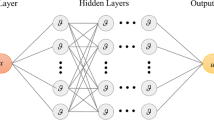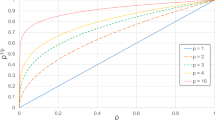Abstract
This paper presents a geometrically nonlinear formulation in boundary representation for the isogeometric analysis of solids. The proposed formulation employs the parameterization of the scaled boundary finite element method. Thus, the geometry of the boundary is sufficient to describe the entire domain. In contrast to the scaled boundary finite element method, NURBS basis functions approximate the solution on the boundary and also in the interior of the domain. In this way, the exact geometry of the boundary is preserved and geometrically nonlinear problems are treated without further measures. The formulation is derived for two-dimensional domains with arbitrary number of boundaries. Numerical benchmarks evaluate the accuracy and efficiency of the formulation. Furthermore, the influence of the discretization in the interior of the domain and the performance of complex geometries is studied. The proposed formulation compares well with other numerical methods and is suitable for geometries that are designed in boundary representation.




























Similar content being viewed by others
References
Hughes TJR, Cottrell JA, Bazilevs Y (2005) Isogeometric analysis: CAD, finite elements, NURBS, exact geometry and mesh refinement. Comput Methods Appl Mech Eng 194:4135–4195
Cottrell JA, Hughes TJR, Bazilevs Y (2009) Isogeometric analysis: toward integration of CAD and FEA. Wiley, West Sussex
Hughes TJR, Reali A, Sangalli G (2010) Efficient quadrature for NURBS-based isogeometric analysis. Comput Methods Appl Mech Eng 199:301–313
Cottrell JA, Reali A, Bazilevs Y (2006) Isogeometric analysis of structural vibrations. Comput Methods Appl Mech Eng 195:5257–5296
Cottrell JA, Hughes TJR, Reali A (2007) Studies of refinement and continuity in isogeometric structural analysis. Comput Methods Appl Mech Eng 196(4160–4183):41–44
Hughes TJR, Reali A, Sangalli G (2008) Duality and unified analysis of discrete approximations in structural dynamics and wave propagation: comparison of \(p\)-method finite elements with \(k\)-method NURBS. Comput Methods Appl Mech Eng 197:4104–4124
Breitenberger M, Apostolatos A, Philipp B, Wüchner R, Bletzinger KU (2015) Analysis in computer aided design: nonlinear isogeometric B-Rep analysis of shell structures. Comput Methods Appl Mech Eng 284:401–457
Schillinger D, Ruess M, Zander N, Bazilevs Y, Düster A, Rank E (2012) Small and large deformation analysis with the \(p\)- and B-spline versions of the Finite Cell Method. Comput Mech 50:445–478
Rank E, Ruess M, Kollmannsberger S, Schillinger D, Düster A (2012) Geometric modeling, isogeometric analysis and the finite cell method. Comput Methods Appl Mech Eng 249:104–115
Heltai L, Kiendl J, DeSimone A, Reali A (2005) A natural framework for isogeometric fluid–structure interaction based on BEM-shell coupling. Comput Methods Appl Mech Eng 194:4135–4195
Bazilevs Y, Hsu MC, Zhang Y, Wang W, Kvamsdal T, Hentschel S et al (2010) Computational vascular fluid–structure interaction: methodology and application to cerebral aneurysms. Biomech Model Mechanobiol 9(4):481–498
Stroud I (2006) Boundary representation modelling techniques. Springer, London
Song C, Wolf JP (1996) Consistent infinitesimal finite-element cell method: three-dimensional vector wave equation. Int J Numer Methods Eng 39(13):2189–2208
Song C, Wolf JP (1997) The scaled boundary finite-element method—alias consistent infinitesimal finite-element cell method—for elastodynamics. Comput Methods Appl Mech Eng 147:329–355
Song C, Wolf JP (2000) The scaled boundary finite-element method—a primer: solution procedures. Comput Struct 78(1):211–225
Song C (2018) The scaled boundary finite element method: introduction to theory and implementation. Wiley, West Sussex
Natarajan S, Ooi ET, Chiong I, Song C (2014) Convergence and accuracy of displacement based finite element formulations over arbitrary polygons: Laplace interpolants, strain smoothing and scaled boundary polygon formulation. Finite Elem Anal Des 85:101–122
Deeks AJ, Augarde CE (2005) A meshless local Petrov–Galerkin scaled boundary method. Comput Mech 36(3):159–170
He Y, Yang H, Deeks AJ (2012) An Element-free Galerkin (EFG) scaled boundary method. Finite Elem Anal Des 62:28–36
Song C, Wolf JP (1998) The scaled boundary finite-element method: analytical solution in frequency domain. Comput Methods Appl Mech Eng 164(1):249–264
Song C (2004) A matrix function solution for the scaled boundary finite-element equation in statics. Comput Methods Appl Mech Eng 193(23):2325–2356
Lin G, Zhang Y, Hu Z, Zhong H (2014) Scaled boundary isogeometric analysis for 2D elastostatics. Sci China Phys Mech Astron 57(2):286–300
Natarajan S, Wang JC, Song C, Birk C (2015) Isogeometric analysis enhanced by the scaled boundary finite element method. Comput Methods Appl Mech Eng 283:733–762
Klinkel S, Chen L, Dornisch W (2015) A NURBS based hybrid collocation—Galerkin method for the analysis of boundary represented solids. Comput Methods Appl Mech Eng 284:689–711
Gravenkamp H, Natarajan S, Dornisch W (2017) On the use of NURBS-based discretizations in the scaled boundary finite element method for wave propagation problems. Comput Methods Appl Mech Eng 315:867–880
Vu TH, Deeks AJ (2006) Use of higher-order shape functions in the scaled boundary finite element method. Int J Numer Methods Eng 65(10):1714–1733
Ooi ET, Song C, Natarajan S (2016) Construction of high-order complete scaled boundary shape functions over arbitrary polygons with bubble functions. Int J Numer Methods Eng 108(9):1086–1120
He Y, Yang H, Deeks AJ (2014) Use of Fourier shape functions in the scaled boundary method. Eng Anal Bound Elem 41:152–159
Lin Z, Liao S (2011) The scaled boundary FEM for nonlinear problems. Commun Nonlinear Sci Numer Simul 16(1):63–75
Ooi E, Song C, Tin-Loi F (2014) A scaled boundary polygon formulation for elasto-plastic analyses. Comput Methods Appl Mech Eng 268:905–937
Behnke R, Mundil M, Birk C, Kaliske M (2014) A physically and geometrically nonlinear scaled-boundary-based finite element formulation for fracture in elastomers. Int J Numer Methods Eng 99:966–999
Chasapi M, Klinkel S (2018) A scaled boundary isogeometric formulation for the elasto-plastic analysis of solids in boundary representation. Comput Methods Appl Mech Eng 18:475–496
Chen L, Dornisch W, Klinkel S (2015) Hybrid collocation—Galerkin approach for the analysis of surface represented 3D-solids employing SB-FEM. Comput Methods Appl Mech Eng 295:268–289
Chen L, Simeon B, Klinkel S (2016) A NURBS based Galerkin approach for the analysis of solids in boundary representation. Comput Methods Appl Mech Eng 305:777–805
Wolf JP (2002) Response of unbounded soil in scaled boundary finite-element method. Earthq Eng Struct Dyn 31(1):15–32
Gravenkamp H, Natarajan S (2018) Scaled boundary polygons for linear elastodynamics. Comput Methods Appl Mech Eng 333:238–256
Bazilevs Y, Long C, Akkerman I, Benson D, Shashkov MJ (2014) Isogeometric analysis of Lagrangian hydrodynamics: axisymmetric formulation in the rz-cylindrical coordinates. J Comput Phys 262:244–261
Toshniwal D, Speleers H, Hiemstra RR, Hughes TJR (2017) Multi-degree smooth polar splines: a framework for geometric modeling and isogeometric analysis. Comput Methods Appl Mech Eng 316:1005–1061
Arioli C, Shamanskiy A, Klinkel S, Simeon B (2019) Scaled boundary parametrizations in isogeometric analysis. Comput Methods Appl Mech Eng 349:576–594
Taylor RL (2014) FEAP—finite element analysis program. University of California, Berkeley
Dornisch W, Vitucci G, Klinkel S (2015) The weak substitution method—an application of the mortar method for patch coupling in NURBS-based isogeometric analysis. Int J Numer Methods Eng 103:205–234
Simo JC, Armero F (1992) Geometrically non-linear enhanced strain mixed methods and the method of incompatible modes. Int J Numer Methods Eng 33:1413–1449
Mathisen KM, Okstad KM, Kvamsdal T, Raknes SB (2011) Isogeometric analysis of finite deformation nearly incompressible solids. J Struct Mech 44:260–278
Chasapi M, Klinkel S (2018) Scaled boundary isogeometric analysis of large deformations in solids. Proc Appl Math Mech 18(1):e201800155
Chasapi M, Klinkel S (2019) A physically and geometrically nonlinear formulation for isogeometric analysis of solids in boundary representation. Proc Appl Math Mech 19(1):e201900131
Acknowledgements
The authors wish to thank Clarissa Arioli and Bernd Simeon from the Technical University of Kaiserslautern for the fruitful discussions on the scaled boundary approach. The financial support of the DFG (German Research Foundation) under Grant No. KL1345/10-1 is gratefully acknowledged.
Author information
Authors and Affiliations
Corresponding author
Additional information
Publisher's Note
Springer Nature remains neutral with regard to jurisdictional claims in published maps and institutional affiliations.
Rights and permissions
About this article
Cite this article
Chasapi, M., Klinkel, S. Geometrically nonlinear analysis of solids using an isogeometric formulation in boundary representation. Comput Mech 65, 355–373 (2020). https://doi.org/10.1007/s00466-019-01772-6
Received:
Accepted:
Published:
Issue Date:
DOI: https://doi.org/10.1007/s00466-019-01772-6




